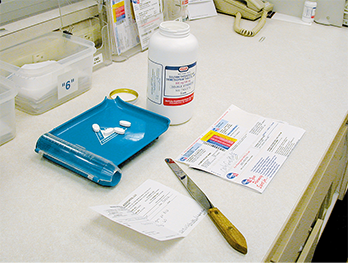7.10 The Pharmacist’s Final Check
It is extremely important—and required by law—that the pharmacist checks every prescription before it is dispensed to the patient to verify and approve its accuracy. Typically, the pharmacy technician will present the printed electronic, fax, or handwritten prescription and the labeled container with the prescribed medication, NDC number, and drug stock bottle for this final check. The stock bottle of tablets, capsules, or liquid must be provided to check the medication source and its NDC number.

The technician must lay out all the elements of a prescription for checking.
The pharmacist compares the prescription with the patient profile, confirms that the medication label that has been affixed to the container is accurate, and confirms that the drug selected by the technician is correct. Some experienced pharmacists can identify the characteristic smells and scents of liquids. If there are no preprinted auxiliary labels, the pharmacist may choose or ask the technician to refer the patient to counseling at pickup. Medication Guides and medication information sheets that are attached to (or inserted in) the paper bag containing the prescription are also checked.
 Practice Tip
Practice Tip
The pharmacist must check all drugs prepared by the pharmacy technician and assume legal responsibility for them.
Additionally, the pharmacist may look over the insurance and billing situation to make sure that the prescribed drug is covered or billed to the correct insurance plan, especially if more than one plan is available. (See Chapter 8.)

Before dispensing, the pharmacist will perform a visual check comparing the original prescription with the labeled instructions and the stock bottle for approval.
After this review, the pharmacist commonly initials the medication container label and/or the original prescription. In doing so, the pharmacist assumes legal responsibility for the correctness of the prescription. However, the pharmacist does not necessarily assume sole responsibility. Technicians have been held legally responsible for dispensing and labeling mistakes, especially in situations in which the dispensing error was the result of negligence on their part or not following established policies and procedures. Most commonly, a wrong dose of medication was retrieved from storage.
 Practice Tip
Practice Tip
Technicians must remember the tasks that are solely the pharmacist’s responsibility: overriding computer DUR alerts, final auxiliary label choices, final approval, and patient medication advice or counseling.
A duplicate of the computer-generated patient container label is usually affixed to the back of the prescription by the pharmacist or the pharmacy technician to provide a paper trail of exactly which product (drug, dose and quantity, directions, and NDC number) was dispensed. It is not uncommon for the verifying pharmacist to initial this copy too, especially in the case of a controlled substance. The original prescription printout with documentation is filed numerically according to the prescription number (automatically assigned by the computer for each prescription). Prescription records must be stored (often in filing boxes or cabinets, with older ones moved to back storage or off-site). Those from the most current months and years must be readily retrievable for potential review and audit. Controlled substances have even more specific documentation and filing rules that are explained in Chapter 14.